Motor skills building process profiling study
Фотографии:
ˑ:
Dr.Sc.Psych., Associate Professor V.I. Goncharov1
Assistant E.A. Mukhachev1
1Pedagogical School of Far-Eastern Federal University, Vladivostok
Keywords: motor skill, profile, express-method, data validity, dependability, reminiscence.
Background. Different matters of the motor skill building process have always been of interest for many researchers in a variety of study fields including physiology, psychology and education, with the interest reaching its peak around 1950-80ies. Presently there appears to be some fall in the interest in these matters that might be due to the practical and procedural problems of their research including, probably, a subjective factor as physiologists and psychologists consider these matters falling within their research field, while educators tend to shy away from them being largely unfamiliar with the physiological and psychological toolkits required for the study data obtaining and processing. It should be also mentioned that still quite a few theoretical and practical matters with concern to the motor skill mastering process are found and need to be studied in more details.
Objective of the study was to profile the motor skills building process using a computerised express-methodology of our own design.
Methods and structure of the study. Having tackled the subject of motor skill building process research we decided first to develop a mobile and time-efficient practical method to generate the motor skill building process profiling data, the data being timely, relevant and convenient for processing, analysing and interpreting. This practical method has been reported in our prior publication designed to test its validity and dependability [1].
The method models the motor skill building process by the test that requires specific word(s) being typed as soon as possible using a computer keyboard with the process time and errors being rated by the test. Subject to the study were 30 trainees of the Children’s and Youth Sport School (CYSS) in Ussuriysk specializing in track-and-field athletics, basketball and kickboxing, each of the three sport-specific groups composed of 10 people. The subjects were tested twice with the difficult words “vital functionality” being typed with a day break. The method generated the following two main test rates: mean arithmetic time of the repetitions required to type the words without errors, and the total errors made in every typing attempt.
Study results and discussion. The first-day tests showed notable progress of every subject by the end of the test session in terms of the typing time and errors: see Figures 1-6.
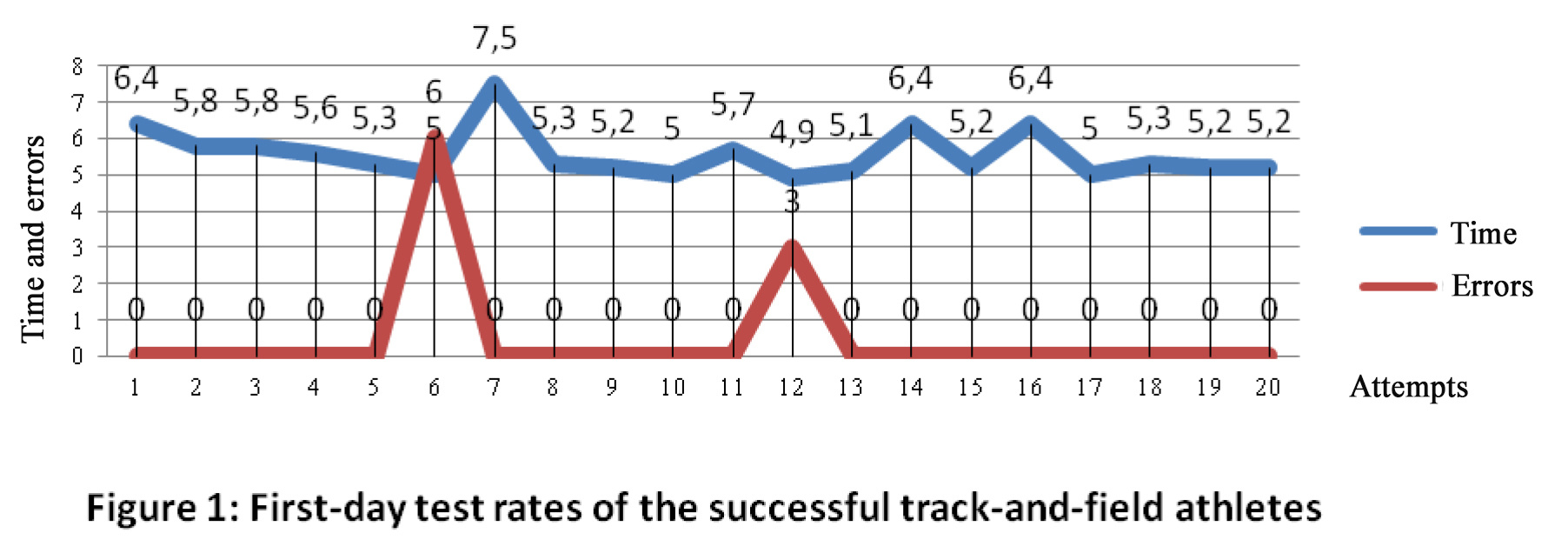
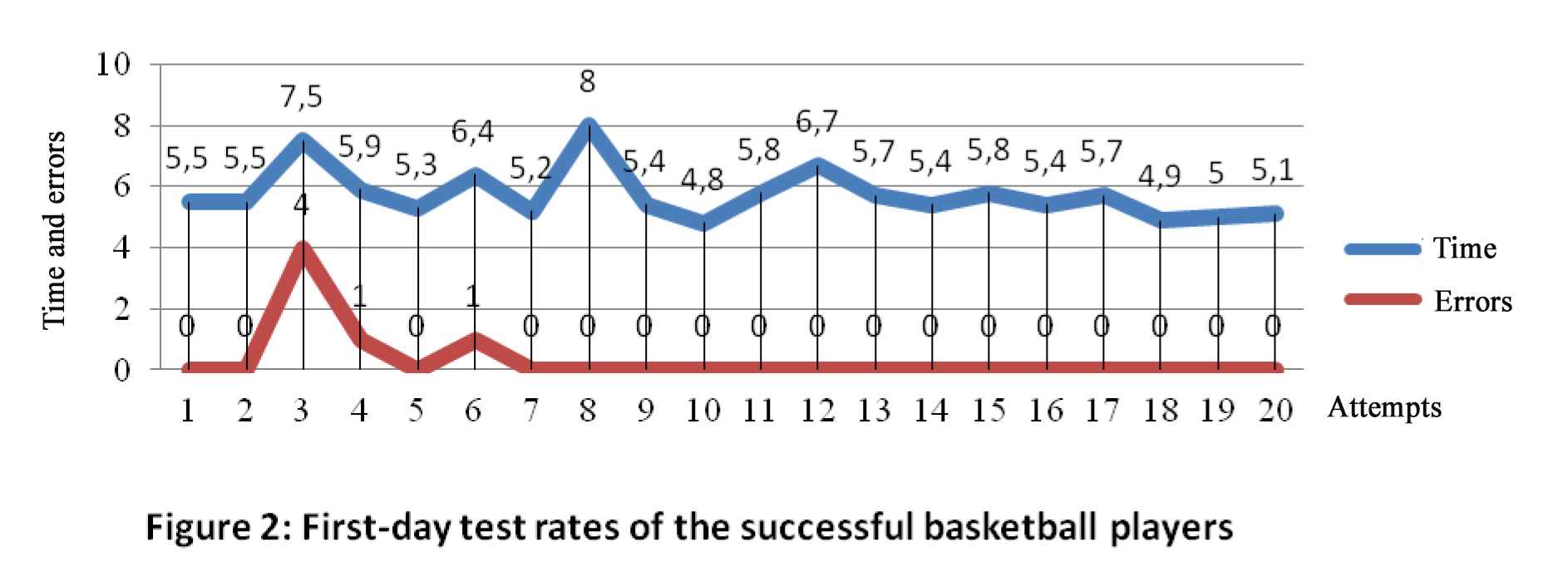
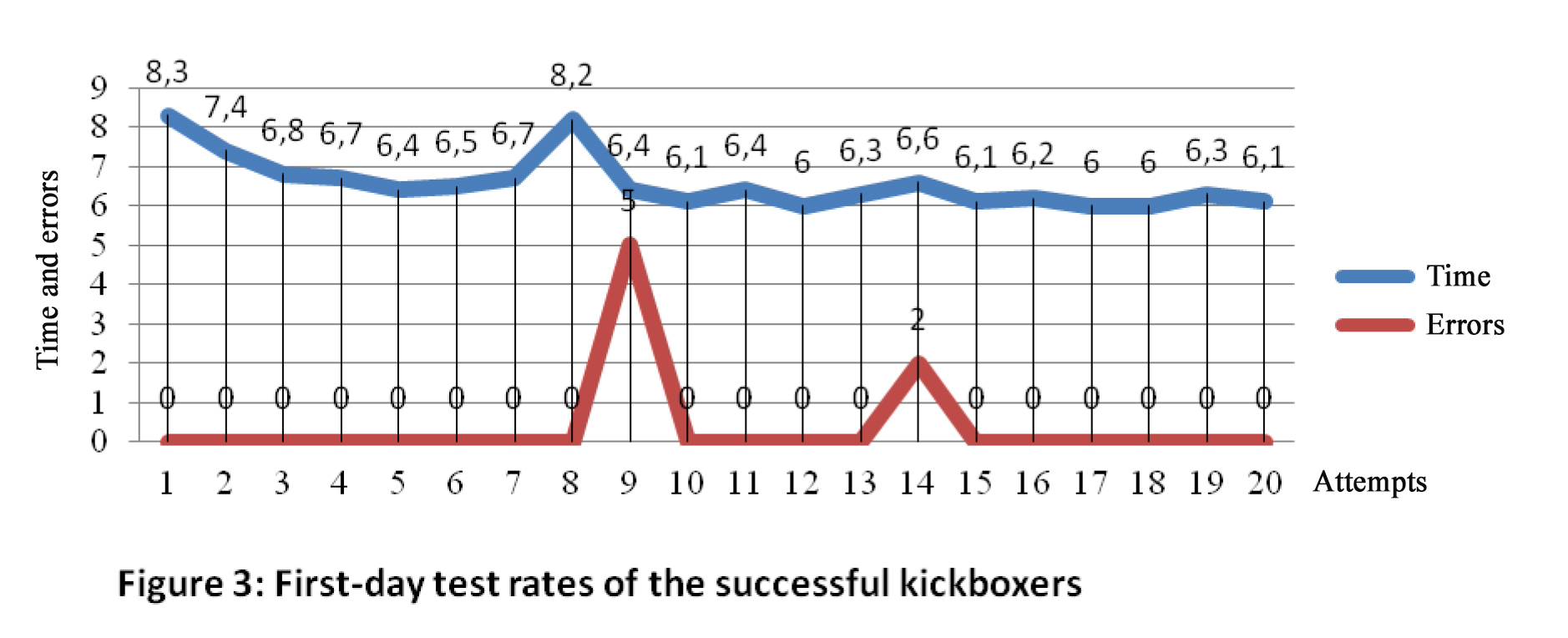

The highest success rate in the first-day tests was achieved by the track-and-field athletes whose average typing rate was tested to grow by 1.2 s by the end of the test with the error rate notably falling (Figure 1), the test data being indicative of the stable progress in the motor skill building process. The same progress was found in the tests of the successful basketaball players (Figure 2) and kickboxers (Figure 3).
The first-day test rates of the less successful subjects are given hereunder in Figures 4, 5 and 6.
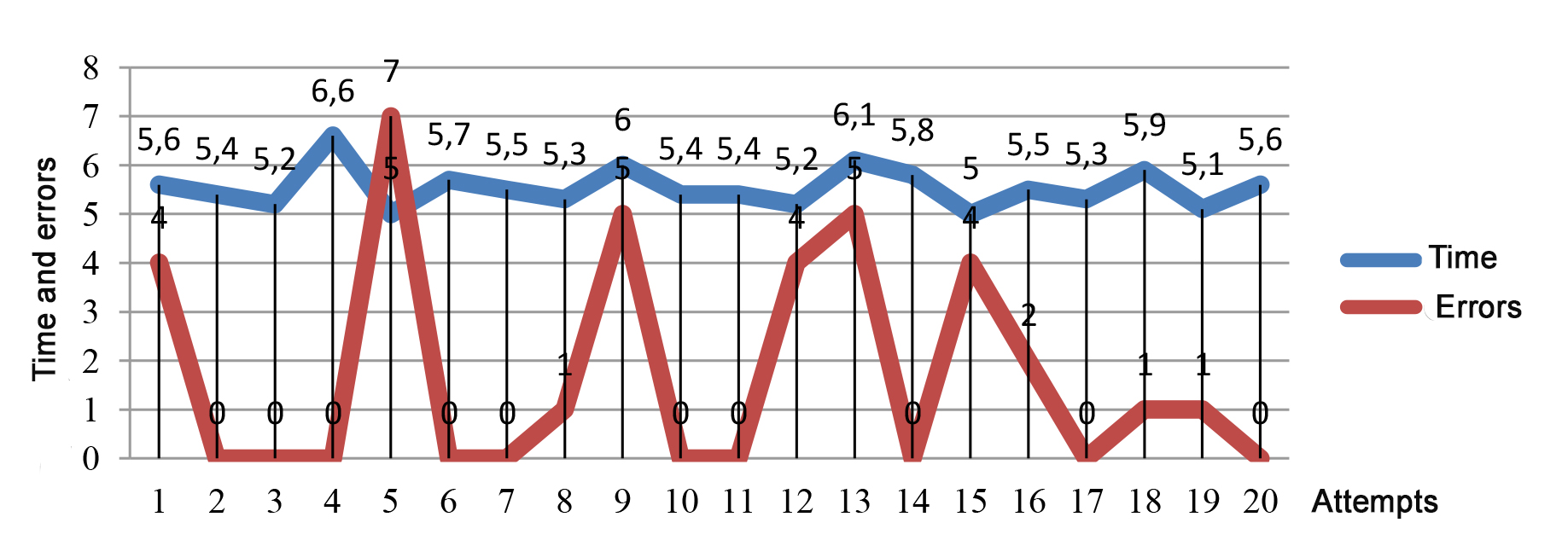
Figure 5. First-day test rates of the less-successful basketball players
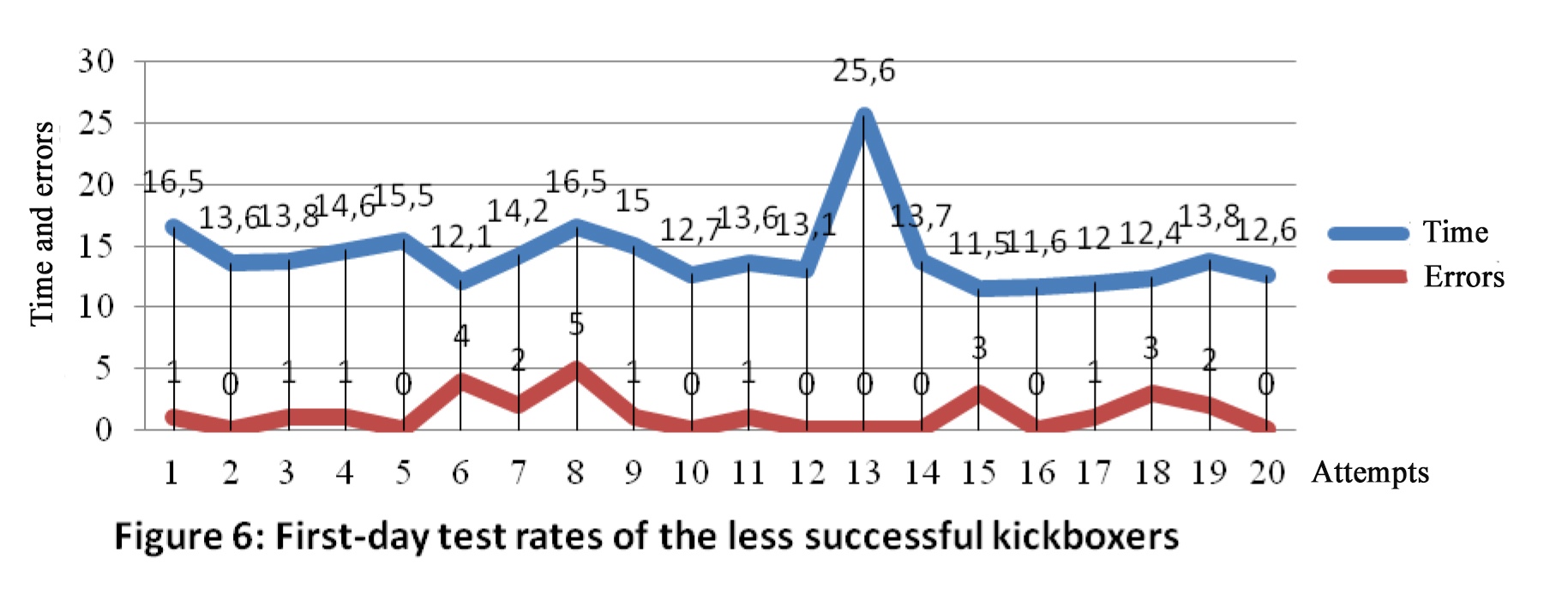
The above figures show the typing time and error rates of these trainees being less stable that may be indicative of certain problems they face in connecting some specific elements of the movement sequence. It should be noted that in some cases the attempts to speed up the typing process resulted in repeated errors that may be due to the forced typing speed being still too high for the current motor skill mastery level. In other cases, on the contrary, we fixed the test rate falling after an error that may be due to the error realizing and frustration sentiments.
In the second-day tests, the successful subjects showed notable progress in the typing rates with falling numbers of errors. The track-and-field athletes, for instance, made only 2 errors on average with the typing rate tested to increase by 1.1 s versus the first-day tests. The successful basketball players made on the second day on average 2 errors less whilst the average typing time dropped by 7.3 s. In the second-day tests, the successful kickboxers’ typing rate was tested to grow by 0.46 s with the errors dropping to only 4.
In the second-day tests, the less successful subjects also showed notable progress in the typing time albeit the error rates stayed the same in the track-and-field athletes and basketball players’ groups; whilst the less-successful kickboxers showed notable reduction of errors versus the first-day tests.
Both the high- and less-successful subjects in every sport group showed notable progress in the second-day tests as verified by the more stable, even and fast typing of the same word that may be interepreted as a progress in the motor skill mastering process. It may be pertinent to highlight that in the first attempt of the second-day test the typing rate in 4 cases out of 6 was tested higher than in the last attempt of the first-day test, although the subject had not practiced typing in between the tests. In the highly-successful subgroups this effect was less expressed and was traced in fact only in the track-and-field athletes, whilst each of the less-successful subgroups showed this effect. It may be assumed that a short-term break in a motor skill practice mostly contributes to the progress without further practices and, therefore, some growth at the start of the next training session is fixed. The lower was the skill building level in the prior test session, the higher was the skill improvement effect at the start of the next session. We assume this effect may be due to the reminiscence phenomenon first reported by D.B. Ballard [1] in his study of the memorising mechanisms.
Conclusion. The subjects showing high rates and quality in the motor skill building process were also tested with high progress in the motor skill shaping and stabilization process. The less-successful subgroups of subjects showed the motor skill building process being less stable that may be due to some individual problems they face in establishing the conditioned-reflective connections between the movement sequence elements, the problems being of negative effect on the motor skill mastering rate and quality. The study found that such an important phenomenon as reminiscence plays an important role not only in the memorizing processes but also in the motor skill building and mastering process.
References
- Goncharov V.I., Mukhachev A.E. Ekspress-metodika dlya issledovaniya protsessa formirovaniya dvigatelnykh navykov [Rapid method to study motor skills building process]. Uchenye zapiski un-ta im. P.F. Legafta, no. 8 (126). St. Petersburg, 2015, pp. 41- 45.
- Ballard D.B. Obliviscence and Reminiscence. The British Journal of Psychological Monography Supplement, vol. I. 1913.
Corresponding author: victorgoncharov@yandex.ru
Abstract
The article considers benefits of the express-method designed by the authors to profile the motor skills building process. The method is based on a software that gives the means to fix and analyse the process data by the test that requires specific words being typed using a computer keyboard. The specific word-processing and typing tasks were designed to help master certain movement sequences that cover every component of the motor skill building process i.e. central, vegetative and peripheral components. The test data analyses produced the data arrays that may be interpreted in many aspects of the motor skills building process related matters, albeit the study was limited by the CYSS trainees only. Objective of the study was to obtain the motor skills building process profiles for the single-phase and multiphase skill-mastering sessions. The motor skills building process data profiles were classified on a success-specific basis, i.e. for highly- and low-successful trainees, with an emphasis on the skill succession processes applied in a sequence of sessions including the reminiscence (memorizing) mechanism application.




